前面这篇文章介绍了 Spring AOP 是如何生成代理对象的,那这篇就是研究代理对象是如何执行的。
那么还是之前的代码为例,将断点打在 bean.addUser() 处。可以看到是 JDK 动态代理的类。
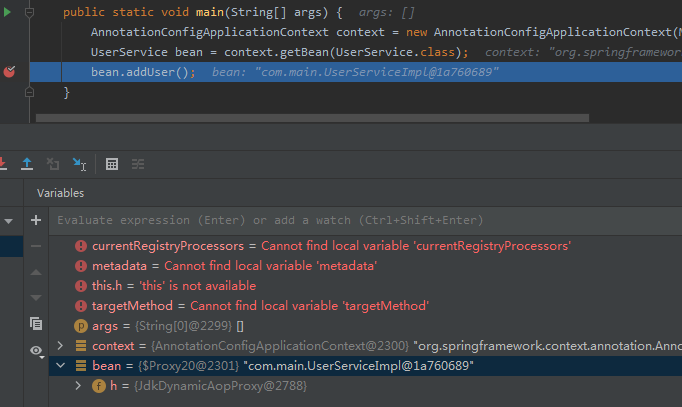
1. JdkDynamicAopProxy # invoke
进入方法,会执行到 JdkDynamicAopProxy 的 invoke 方法中:
public Object invoke(Object proxy, Method method, Object[] args) throws Throwable {
Object oldProxy = null;
boolean setProxyContext = false;
TargetSource targetSource = this.advised.targetSource;
Object target = null;
try {
// equals 方法不代理
if (!this.equalsDefined && AopUtils.isEqualsMethod(method)) {
return equals(args[0]);
}
// hashCode方法不代理
else if (!this.hashCodeDefined && AopUtils.isHashCodeMethod(method)) {
return hashCode();
}
// 来自于DecoratingProxy接口的方法,也不代理
else if (method.getDeclaringClass() == DecoratingProxy.class) {
return AopProxyUtils.ultimateTargetClass(this.advised);
}
// 目标对象本身实现了 Advised 接口,也不代理
else if (!this.advised.opaque && method.getDeclaringClass().isInterface() &&
method.getDeclaringClass().isAssignableFrom(Advised.class)) {
return AopUtils.invokeJoinpointUsingReflection(this.advised, method, args);
}
Object retVal;
if (this.advised.exposeProxy) {
oldProxy = AopContext.setCurrentProxy(proxy);
setProxyContext = true;
}
target = targetSource.getTarget();
Class<?> targetClass = (target != null ? target.getClass() : null);
// 根据当前的方法获取匹配到的增强器
List<Object> chain = this.advised.getInterceptorsAndDynamicInterceptionAdvice(method, targetClass);
if (chain.isEmpty()) {
Object[] argsToUse = AopProxyUtils.adaptArgumentsIfNecessary(method, args);
retVal = AopUtils.invokeJoinpointUsingReflection(target, method, argsToUse);
}
else {
MethodInvocation invocation =
new ReflectiveMethodInvocation(proxy, target, method, args, targetClass, chain);
// 构造增强器链,执行增强器的逻辑
retVal = invocation.proceed();
}
// 返回值的处理
........
return retVal;
} // finally
.........
}1.1 getInterceptorsAndDynamicInterceptionAdvice
// AdvisedSupport
public List<Object> getInterceptorsAndDynamicInterceptionAdvice(Method method, @Nullable Class<?> targetClass) {
MethodCacheKey cacheKey = new MethodCacheKey(method);
List<Object> cached = this.methodCache.get(cacheKey);
if (cached == null) {
cached = this.advisorChainFactory.getInterceptorsAndDynamicInterceptionAdvice(
this, method, targetClass);
this.methodCache.put(cacheKey, cached);
}
return cached;
}第一次执行后,后续执行都从缓存中取数据。核心是 getInterceptorsAndDynamicInterceptionAdvice 方法。这个方法代码有点长,拆开来看:
1.1.1 getInterceptorsAndDynamicInterceptionAdvice
这个方法代码有点长,拆开来看:
1.1.1.1 准备工作
// DefaultAdvisorChainFactory
public List<Object> getInterceptorsAndDynamicInterceptionAdvice(
Advised config, Method method, @Nullable Class<?> targetClass) {
AdvisorAdapterRegistry registry = GlobalAdvisorAdapterRegistry.getInstance();
Advisor[] advisors = config.getAdvisors();
List<Object> interceptorList = new ArrayList<>(advisors.length);
Class<?> actualClass = (targetClass != null ? targetClass : method.getDeclaringClass());
Boolean hasIntroductions = null;
......
}这里初始化了一个 AdvisorAdapterRegistry,名字的意思是增强器适配器的注册器。而实际也确实注册了增强器适配器。
// GlobalAdvisorAdapterRegistry
private static AdvisorAdapterRegistry instance = new DefaultAdvisorAdapterRegistry();
public static AdvisorAdapterRegistry getInstance() {
return instance;
}
// DefaultAdvisorAdapterRegistry
public DefaultAdvisorAdapterRegistry() {
// 注册了三个增强器适配器
registerAdvisorAdapter(new MethodBeforeAdviceAdapter());
registerAdvisorAdapter(new AfterReturningAdviceAdapter());
registerAdvisorAdapter(new ThrowsAdviceAdapter());
}看名字的这三个增强器适配器分别对应
@Before、@AfterReturning、@AfterThrowing,其他两个注解@After、@Around没有对应的增强器适配器吗? 别急,这个接下来会说到。
而之前 buildAdvisors 已经把此代理对象匹配到的增强器收集到了,并放入到了 JdkDynamicAopProxy 的 AdvisedSupport 对象中,config.getAdvisors(); 的 config 类型就是 AdvisedSupport 。然后再对方法进行匹配。
1.1.1.2 方法匹配
......
for (Advisor advisor : advisors) {
if (advisor instanceof PointcutAdvisor) {
// 这里是 AspectJ 形式封装的 advisor
PointcutAdvisor pointcutAdvisor = (PointcutAdvisor) advisor;
if (config.isPreFiltered() || pointcutAdvisor.getPointcut().getClassFilter().matches(actualClass)) {
// 根据通知方法上的切入点表达式,判断是否可以匹配当前要执行的目标对象所属类
MethodMatcher mm = pointcutAdvisor.getPointcut().getMethodMatcher();
boolean match;
if (mm instanceof IntroductionAwareMethodMatcher) {
if (hasIntroductions == null) {
hasIntroductions = hasMatchingIntroductions(advisors, actualClass);
}
match = ((IntroductionAwareMethodMatcher) mm).matches(method, actualClass, hasIntroductions);
}
else {
match = mm.matches(method, actualClass);
}
if (match) {
MethodInterceptor[] interceptors = registry.getInterceptors(advisor);
if (mm.isRuntime()) {
// Creating a new object instance in the getInterceptors() method
// isn't a problem as we normally cache created chains.
for (MethodInterceptor interceptor : interceptors) {
interceptorList.add(new InterceptorAndDynamicMethodMatcher(interceptor, mm));
}
}
else {
interceptorList.addAll(Arrays.asList(interceptors));
}
}
}
}
.....这里和之前一样,通过 MethodMatcher 进行匹配。
1.1.1.3 封装为 MethodInterceptor
匹配到增强器之后,封装为 MethodInterceptor。
if (match) {
MethodInterceptor[] interceptors = registry.getInterceptors(advisor);
if (mm.isRuntime()) {
// Creating a new object instance in the getInterceptors() method
// isn't a problem as we normally cache created chains.
for (MethodInterceptor interceptor : interceptors) {
interceptorList.add(new InterceptorAndDynamicMethodMatcher(interceptor, mm));
}
}
else {
interceptorList.addAll(Arrays.asList(interceptors));
}
}public MethodInterceptor[] getInterceptors(Advisor advisor) throws UnknownAdviceTypeException {
List<MethodInterceptor> interceptors = new ArrayList<>(3);
Advice advice = advisor.getAdvice();
if (advice instanceof MethodInterceptor) {
interceptors.add((MethodInterceptor) advice);
}
// 如果对应的 advice 没有实现 MethodInterceptor 的话,就需要通过适配器来获取
for (AdvisorAdapter adapter : this.adapters) {
if (adapter.supportsAdvice(advice)) {
interceptors.add(adapter.getInterceptor(advisor));
}
}
if (interceptors.isEmpty()) {
throw new UnknownAdviceTypeException(advisor.getAdvice());
}
return interceptors.toArray(new MethodInterceptor[0]);
} 看到这里是不是就知道了为什么 AdvisorAdapterRegistry 只注册了三个增强器适配器,因为 @Before、@AfterReturning 注解对应的 Advice:AspectJMethodBeforeAdvice、AspectJAfterReturningAdvice 没有实现 MethodInterceptor 接口,而 @After、@Around 、@AfterThrowing 对应的 Advice:AspectJAfterAdvice、AspectJAroundAdvice 、AspectJAfterThrowingAdvice 实现了 MethodInterceptor 接口。小伙伴可以自行 debug 试验一下。
那还有一个 ThrowsAdviceAdapter 呢?这个主要是处理实现 ThrowsAdvice 接口的类,用来处理异常,对于 ThrowsAdvice 的注解模式,Spring 没有直接提供支持,在注解模式下,我们通常使用更为灵活的 @AfterThrowing 注解来处理方法抛出的异常,所以这里不过多讲,感兴趣的可以自行研究。
adapter.getInterceptor(advisor) 就是将 advisor 中的 advice 取出封装为 MethodInterceptor 。
1.1.1.4 其他增强器的处理
其他增强器我们一般碰不到,AspectJ 形式的都是走上面的逻辑,所以这里不深入研究了。
1.2 ReflectiveMethodInvocation # proceed
增强器筛选出来后,下面就是构建方法执行器,执行它的 proceed 方法。
public Object proceed() throws Throwable {
if (this.currentInterceptorIndex == this.interceptorsAndDynamicMethodMatchers.size() - 1) {
// 所有增强器执行完毕后,才执行目标方法
return invokeJoinpoint();
}
Object interceptorOrInterceptionAdvice =
this.interceptorsAndDynamicMethodMatchers.get(++this.currentInterceptorIndex);
if (interceptorOrInterceptionAdvice instanceof InterceptorAndDynamicMethodMatcher) {
InterceptorAndDynamicMethodMatcher dm =
(InterceptorAndDynamicMethodMatcher) interceptorOrInterceptionAdvice;
Class<?> targetClass = (this.targetClass != null ? this.targetClass : this.method.getDeclaringClass());
if (dm.methodMatcher.matches(this.method, targetClass, this.arguments)) {
return dm.interceptor.invoke(this);
}
else {
return proceed();
}
}
else {
return ((MethodInterceptor) interceptorOrInterceptionAdvice).invoke(this);
}
}打断点,查看 userService 的拦截器:
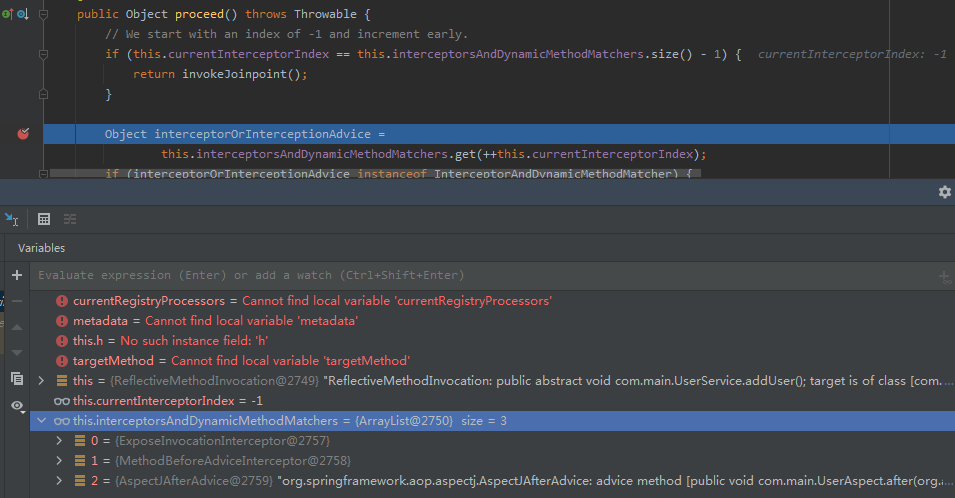 1.2.1 执行第一个增强器
1.2.1 执行第一个增强器
又回到之前说过的 ExposeInvocationInterceptor,ExposeInvocationInterceptor 不是 InterceptorAndDynamicMethodMatcher ,走的最下面那个 else 中的方法,最终进入到它的 invoke 方法。这个方法前面说过了,下一步继续执行 proceed 方法。又回到 7.2 的 proceed 。
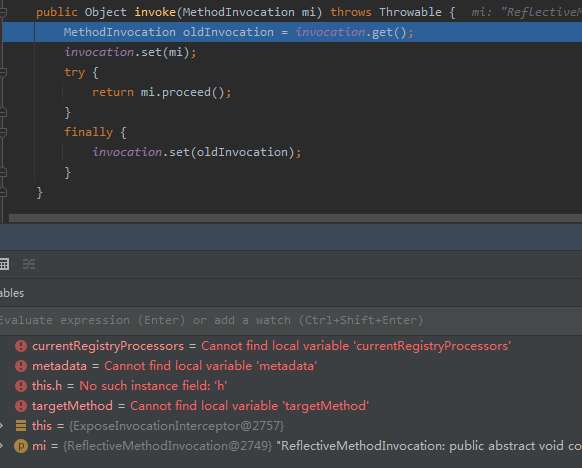 1.2.2 执行 MethodBeforeAdviceInterceptor
1.2.2 执行 MethodBeforeAdviceInterceptor
对 MethodBeforeAdviceInterceptor 的处理逻辑是一样的,最终进入到它的 invoke 方法,然后回调 proceed 方法。
// MethodBeforeAdviceInterceptor
public Object invoke(MethodInvocation mi) throws Throwable {
this.advice.before(mi.getMethod(), mi.getArguments(), mi.getThis());
return mi.proceed();
}对于剩下的拦截器,处理流程都是类似的,不再过多赘述了。
1.3 CGLIB 代理
对于 cglib 代理呢,会进入到 CglibAopProxy 的内部类 DynamicAdvisedInterceptor 中。核心是:
public Object intercept(Object proxy, Method method, Object[] args, MethodProxy methodProxy) throws Throwable {
.......
List<Object> chain = this.advised.getInterceptorsAndDynamicInterceptionAdvice(method, targetClass);
.......
retVal = new CglibMethodInvocation(proxy, target, method, args, targetClass, chain, methodProxy).proceed();
.......
}是不是有点熟悉,CGLIB 代理的处理逻辑和 JDK 动态代理是类似。构造了 CglibMethodInvocation ,执行 proceed 方法,而 CglibMethodInvocation 继承自 ReflectiveMethodInvocation,所以实际上就是执行 ReflectiveMethodInvocation 的 proceed 方法。和 7.2 章节中一样。
2. @EnableAspectJAutoProxy 的 exposeProxy
@EnableAspectJAutoProxy 除了有 proxyTargetClass 这个属性,还有另外一个是 exposeProxy,意为暴露代理,那这个有什么用呢?修改一下代码做个测试。
public interface UserService {
void addUser();
void findUser();
}
@Service
public class UserServiceImpl implements UserService {
@Override
public void addUser() {
findUser();
System.out.println("addUser 方法执行了");
}
@Override
public void findUser() {
System.out.println("findUser 方法执行了");
}
}
@Aspect
@Component
public class UserAspect {
@Before("execution(public * com.main.UserService.*(..))")
public void before(JoinPoint joinPoint) {
System.out.println("代理方法执行前");
}
}
public class Main {
public static void main(String[] args) {
AnnotationConfigApplicationContext context = new AnnotationConfigApplicationContext(MainConfiguration.class);
UserService bean = context.getBean(UserService.class);
bean.addUser();
}
}给 userService 加了一个 findUser 方法,然后在 addUser 方法中加了一行 this.findUser(),执行 main 方法,可以先猜一下控制台的输出,理想情况下应该是这样的:
代理方法执行前
代理方法执行前
findUser 方法执行了
addUser 方法执行了 但实际上控制输出如下,只打印了一次切面日志:
代理方法执行前
findUser 方法执行了
addUser 方法执行了那想要每次调用 userService 方法之前都打印一次日志要怎么改?简单的话可以这样:
@Service
public class UserService {
@Autowired
UserService userService;
@Override
public void addUser() {
userService.findUser();
System.out.println("addUser 方法执行了");
}
@Override
public void findUser() {
System.out.println("findUser 方法执行了");
}
} 但是这种方法很臃肿,实际开发也不会这样写。那要怎么做? 你想要的这种效果,Spring 肯定想到了,它提供了一个 AopContext 类,使用这个类,可以获取到代理对象本身:
public void addUser() {
((UserService) AopContext.currentProxy()).findUser();
System.out.println("addUser 方法执行了");
}使用 AopContext.currentProxy() 方法就可以取到代理对象的 this 了。但是这样还不行哦,直接运行会报错:

看错误提示需要把 exposeProxy 设置为 true,而这个属性正好在 @EnableAspectJAutoProxy 注解上,默认值为 false,改为 true 重新运行,就会发现打印两次切面日志了。
@Configuration
@ComponentScan("com.main")
@EnableAspectJAutoProxy(exposeProxy = true)
public class MainConfiguration {
}3. AspectJ 拦截不到接口上面的注解
改造之前的代码:
@Retention(RetentionPolicy.RUNTIME)
@Target(ElementType.METHOD)
@Documented
public @interface UserLog {
}
public interface UserService {
@UserLog
void addUser();
}
@Service
public class UserServiceImpl implements UserService {
@Override
public void addUser() {
System.out.println("addUser 方法执行了");
}
}
@Aspect
@Component
public class UserAspect {
@Pointcut("@annotation(com.main.UserLog)")
public void withinPointcut() {
}
@Before("withinPointcut()")
public void before(JoinPoint joinPoint) {
System.out.println("代理方法执行前");
}
}
public class Main {
public static void main(String[] args) {
AnnotationConfigApplicationContext context = new AnnotationConfigApplicationContext(MainConfiguration.class);
UserService bean = context.getBean(UserService.class);
bean.addUser();
}
}新增一个注解 UserLog,切面拦截这个注解,在接口 UserService 的方法 addUser 方法加上这个注解执行 main 方法,结果如下:
addUser 方法执行了而将注解配到 UserServiceImpl 的 addUser 方法上,结果是不一样的:
代理方法执行前
addUser 方法执行了结果说明切面并没有拦截到接口方法上面的注解,只拦截到了实现类方法上面的注解,这是为什么呢?
3.1 增强器的筛选
之前 AOP 源码分析过增强器的收集和匹配,没拦截到就肯定没有匹配到,所以还是得从源码分析。对 bean 的增强器的收集和匹配在 AbstractAdvisorAutoProxyCreator # getAdvicesAndAdvisorsForBean处,不记得的小伙伴回到上面的章节再熟悉一下哦。
protected List<Advisor> findEligibleAdvisors(Class<?> beanClass, String beanName) {
List<Advisor> candidateAdvisors = findCandidateAdvisors();
List<Advisor> eligibleAdvisors = findAdvisorsThatCanApply(candidateAdvisors, beanClass, beanName);
extendAdvisors(eligibleAdvisors);
.......
}findCandidateAdvisors 是找出容器中所有的增强器,findAdvisorsThatCanApply 是根据当前 bean 进行筛选,分别在这两个方法执行后打断点查看结果。
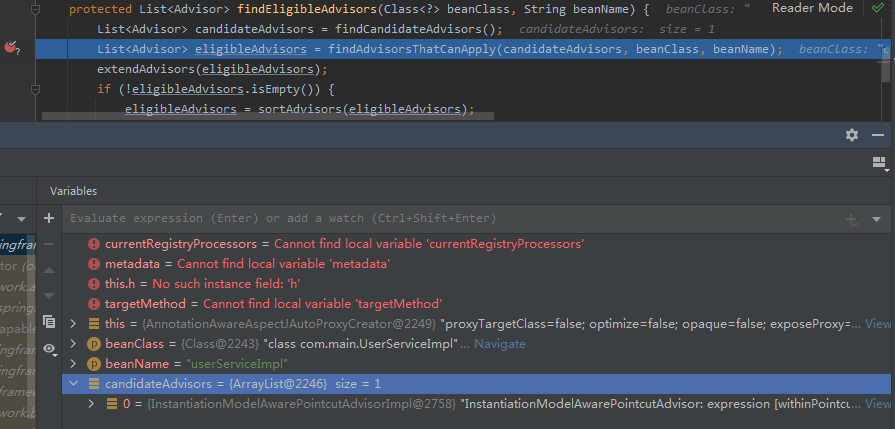

findCandidateAdvisors 已经把 UserAspect 中的增强器拿到了,但是下一步筛选的 eligibleAdvisors 为0,说明 UserAspect 的增强器匹配不到接口上面的注解。所以真正的原因就在 findAdvisorsThatCanApply 方法里面,这个方法前面也分析过,所以这里就根据调用链直接定位。
// AopUtils
public static boolean canApply(Pointcut pc, Class<?> targetClass, boolean hasIntroductions) {
.........
for (Class<?> clazz : classes) {
Method[] methods = ReflectionUtils.getAllDeclaredMethods(clazz);
for (Method method : methods) {
if (introductionAwareMethodMatcher != null ?
introductionAwareMethodMatcher.matches(method, targetClass, hasIntroductions) :
methodMatcher.matches(method, targetClass)) {
return true;
}
}
}
return false;
}这里 introductionAwareMethodMatcher != null 为 true,就会执行 introductionAwareMethodMatcher.matches(method, targetClass, hasIntroductions),而这个都是返回 false ,最终跳出 for 循环执行 return 语句返回 false,而 canApply 返回 fasle 说明增强器没匹配上,所以需要了解原因还得进 introductionAwareMethodMatcher.matches 里面看,这个之前是没有分析过的。
// AspectJExpressionPointcut
public boolean matches(Method method, Class<?> targetClass, boolean hasIntroductions) {
obtainPointcutExpression();
ShadowMatch shadowMatch = getTargetShadowMatch(method, targetClass);
if (shadowMatch.alwaysMatches()) {
return true;
}
else if (shadowMatch.neverMatches()) {
return false;
}
else {
if (hasIntroductions) {
return true;
}
RuntimeTestWalker walker = getRuntimeTestWalker(shadowMatch);
return (!walker.testsSubtypeSensitiveVars() || walker.testTargetInstanceOfResidue(targetClass));
}
}这里判断是否匹配是通过 shadowMatch.alwaysMatches() 和 shadowMatch.neverMatches() ,ShadowMatch 是接口,具体方法逻辑得看实现类,可以将断点打在 shadowMatch.alwaysMatches() 行,发现实现类是 ShadowMatchImpl。
public class ShadowMatchImpl implements ShadowMatch {
........
private FuzzyBoolean match;
........
public boolean alwaysMatches() {
return match.alwaysTrue();
}
public boolean neverMatches() {
return match.alwaysFalse();
}
} 而这两个方法都是通过变量 match 判断的,这里变量的类型是 FuzzyBoolean。FuzzyBoolean 有四个子类
public static final FuzzyBoolean YES = new YesFuzzyBoolean();
public static final FuzzyBoolean NO = new NoFuzzyBoolean();
public static final FuzzyBoolean MAYBE = new MaybeFuzzyBoolean();
public static final FuzzyBoolean NEVER = new NeverFuzzyBoolean();所以关键点是找到 ShadowMatch 中构造 FuzzyBoolean 的地方,方法一步一步往下走:
// AspectJExpressionPointcut
private ShadowMatch getTargetShadowMatch(Method method, Class<?> targetClass) {
..........
return getShadowMatch(targetMethod, method);
}
private ShadowMatch getShadowMatch(Method targetMethod, Method originalMethod) {
// 先从缓存中取
ShadowMatch shadowMatch = this.shadowMatchCache.get(targetMethod);
if (shadowMatch == null) {
.........
shadowMatch = obtainPointcutExpression().matchesMethodExecution(methodToMatch);
.........
}
return shadowMatch;
}// PointcutExpressionImpl
public ShadowMatch matchesMethodExecution(Method aMethod) {
ShadowMatch match = matchesExecution(aMethod);
.....
return match;
}
private ShadowMatch matchesExecution(Member aMember) {
Shadow s = ReflectionShadow.makeExecutionShadow(world, aMember, this.matchContext);
ShadowMatchImpl sm = getShadowMatch(s);
sm.setSubject(aMember);
sm.setWithinCode(null);
sm.setWithinType(aMember.getDeclaringClass());
return sm;
}
private ShadowMatchImpl getShadowMatch(Shadow forShadow) {
org.aspectj.util.FuzzyBoolean match = pointcut.match(forShadow);
Test residueTest = Literal.TRUE;
ExposedState state = getExposedState();
if (match.maybeTrue()) {
residueTest = pointcut.findResidue(forShadow, state);
}
ShadowMatchImpl sm = new ShadowMatchImpl(match, residueTest, state, parameters);
sm.setMatchingContext(this.matchContext);
return sm;
}到这里就比较清晰了,pointcut.match(forShadow) 即根据切入点匹配返回了一个 FuzzyBoolean 变量,并作为 ShadowMatchImpl 构造方法里面的参数。进一步到 pointcut.match(forShadow) 方法中
// PointCut
public final FuzzyBoolean match(Shadow shadow) {
if (shadow.shadowId == lastMatchedShadowId) {
return lastMatchedShadowResult;
}
FuzzyBoolean ret;
// this next test will prevent a lot of un-needed matching going on....
if (shadow.getKind().isSet(couldMatchKinds())) {
ret = matchInternal(shadow);
} else {
ret = FuzzyBoolean.NO;
}
lastMatchedShadowId = shadow.shadowId;
lastMatchedShadowResult = ret;
return ret;
}这里有一个 if 判断,将断点打在此处,可以看到会进入到 if 方法体里面执行 matchInternal 方法。
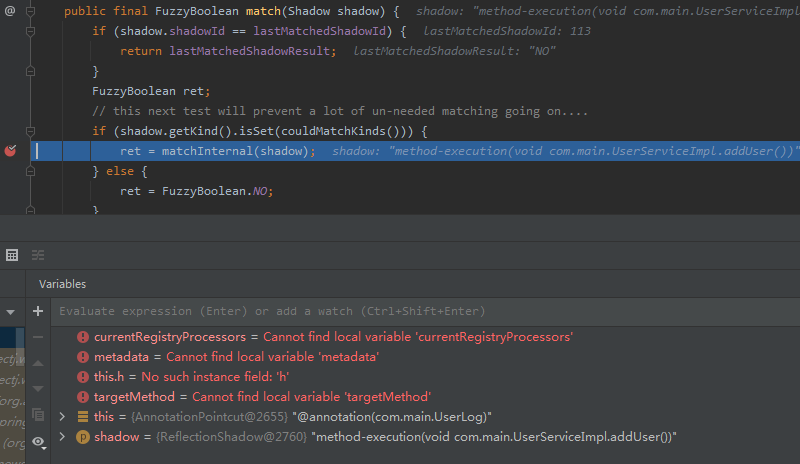
进入 matchInternal 方法,一步一步调试
protected FuzzyBoolean matchInternal(Shadow shadow) {
AnnotatedElement toMatchAgainst = null;
Member member = shadow.getSignature();
ResolvedMember rMember = member.resolve(shadow.getIWorld());
if (rMember == null) {
if (member.getName().startsWith(NameMangler.PREFIX)) {
return FuzzyBoolean.NO;
}
shadow.getIWorld().getLint().unresolvableMember.signal(member.toString(), getSourceLocation());
return FuzzyBoolean.NO;
}
Shadow.Kind kind = shadow.getKind();
if (kind == Shadow.StaticInitialization) {
toMatchAgainst = rMember.getDeclaringType().resolve(shadow.getIWorld());
} else if ((kind == Shadow.ExceptionHandler)) {
toMatchAgainst = rMember.getParameterTypes()[0].resolve(shadow.getIWorld());
} else {
toMatchAgainst = rMember;
if (rMember.isAnnotatedElsewhere()) {
........
}
}
annotationTypePattern.resolve(shadow.getIWorld());
// 最后走到这里
return annotationTypePattern.matches(toMatchAgainst);
}// ExactAnnotationTypePattern
public FuzzyBoolean matches(AnnotatedElement annotated) {
return matches(annotated, null);
}
public FuzzyBoolean matches(AnnotatedElement annotated, ResolvedType[] parameterAnnotations) {
if (!isForParameterAnnotationMatch()) {
boolean checkSupers = false;
if (getResolvedAnnotationType().isInheritedAnnotation()) {
if (annotated instanceof ResolvedType) {
checkSupers = true;
}
}
if (annotated.hasAnnotation(annotationType)) {
........
return FuzzyBoolean.YES;
} else if (checkSupers) {
........
}
} else {
........
}
return FuzzyBoolean.NO;
}核心是 annotated.hasAnnotation(annotationType),断点到此处:
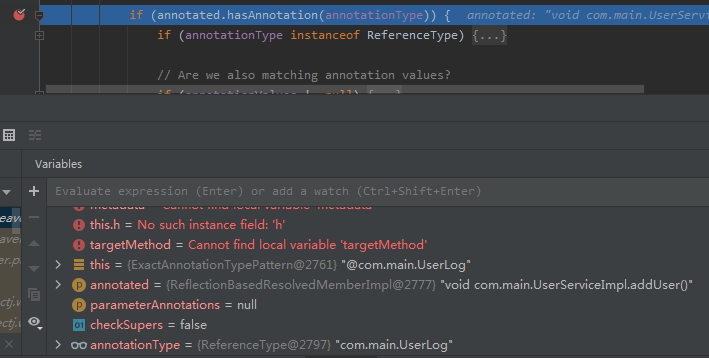
6.2.2 章节中创建代理对象时会取出被代理对象的所有方法进行匹配,这里 annotated 就可以看做是取出的某一个方法,annotationType 即为要匹配的类型,这里是 UserLog 注解。这一行就是判断方法上是否有对应注解。
// ReflectionBasedResolvedMemberImpl
public boolean hasAnnotation(UnresolvedType ofType) {
boolean areRuntimeRetentionAnnotationsSufficient = false;
if (ofType instanceof ResolvedType) {
areRuntimeRetentionAnnotationsSufficient = ((ResolvedType)ofType).isAnnotationWithRuntimeRetention();
}
unpackAnnotations(areRuntimeRetentionAnnotationsSufficient);
// 调用父类方法
return super.hasAnnotation(ofType);
}
// 父类 ResolvedMemberImpl
protected ResolvedType[] annotationTypes = null;
public boolean hasAnnotation(UnresolvedType ofType) {
if (backingGenericMember != null) {
if (annotationTypes != null) {
throw new BCException("Unexpectedly found a backing generic member and a local set of annotations");
}
return backingGenericMember.hasAnnotation(ofType);
}
if (annotationTypes != null) {
for (int i = 0, max = annotationTypes.length; i < max; i++) {
if (annotationTypes[i].equals(ofType)) {
return true;
}
}
}
return false;
}最终调用父类的 hasAnnotation 判断,遍历 annotationTypes 查找是否含有对应注解。这里猜测一下 annotationTypes 就是方法上的所有注解数组,而 hasAnnotation 中并没有初始化 annotationTypes 的地方。调用父类的 hasAnnotation 前还有一行方法调用: unpackAnnotations,看名字是解包注解的意思,点进去看一下,唉,就是在这里初始化的哦。
其实没有这么凑巧哦,都是一步一步调试找到的。
private void unpackAnnotations(boolean areRuntimeRetentionAnnotationsSufficient) {
if (annotationFinder != null && (annotationTypes == null || (!areRuntimeRetentionAnnotationsSufficient && onlyRuntimeAnnotationsCached))) {
// 这里
annotationTypes = annotationFinder.getAnnotations(reflectMember, areRuntimeRetentionAnnotationsSufficient);
onlyRuntimeAnnotationsCached = areRuntimeRetentionAnnotationsSufficient;
}
}通过注解查找器 annotationFinder 获取方法上面的注解。
public ResolvedType[] getAnnotations(Member onMember, boolean areRuntimeAnnotationsSufficient) {
if (!(onMember instanceof AccessibleObject)) {
return ResolvedType.NONE;
}
if (!areRuntimeAnnotationsSufficient) {
........
}
AccessibleObject ao = (AccessibleObject) onMember;
// 这里获取注解
Annotation[] anns = ao.getDeclaredAnnotations();
if (anns.length == 0) {
return ResolvedType.NONE;
}
ResolvedType[] annotationTypes = new ResolvedType[anns.length];
for (int i = 0; i < anns.length; i++) {
annotationTypes[i] = UnresolvedType.forName(anns[i].annotationType().getName()).resolve(world);
}
return annotationTypes;
}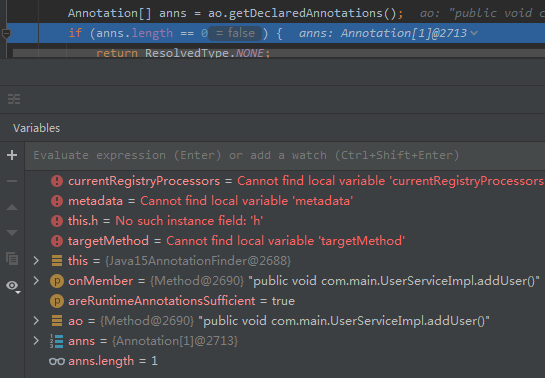
ao 就是 Method 对象,而 Method 的 getDeclaredAnnotations 方法只能获取到实现类本身方法上的注解,不能获取到对应接口方法上的注解。
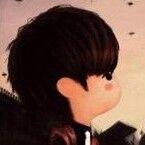


评论区